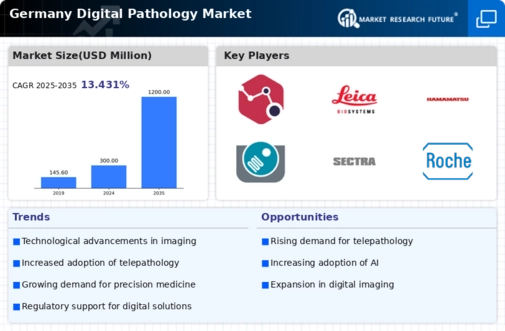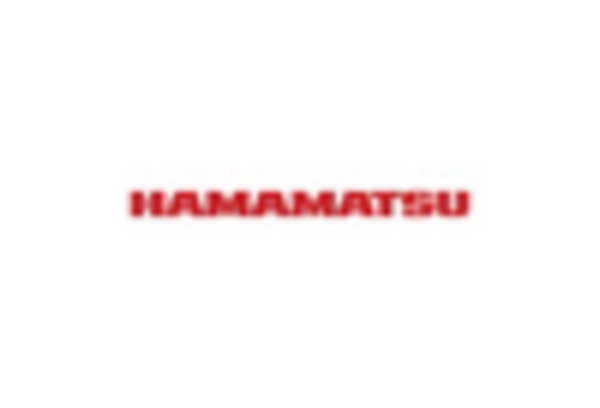The digital pathology market in Germany is characterized by a dynamic competitive landscape, driven by technological advancements and increasing demand for efficient diagnostic solutions. Key players such as Philips (NL), Roche (CH), and 3DHISTECH (HU) are at the forefront, leveraging innovation and strategic partnerships to enhance their market positions. Philips (NL) focuses on integrating AI capabilities into its digital pathology solutions, aiming to streamline workflows and improve diagnostic accuracy. Meanwhile, Roche (CH) emphasizes its commitment to personalized medicine, aligning its digital pathology offerings with broader healthcare trends. 3DHISTECH (HU) is known for its robust imaging solutions, which are increasingly being adopted in clinical settings, thereby shaping the competitive environment through technological differentiation.
The market structure appears moderately fragmented, with several players vying for market share. Companies are adopting various business tactics, such as localizing manufacturing and optimizing supply chains, to enhance operational efficiency. This competitive structure allows for a diverse range of offerings, although the influence of major players remains significant. The collective strategies of these companies indicate a trend towards consolidation, as they seek to leverage synergies and expand their geographic reach.
In October 2025, Roche (CH) announced a strategic partnership with a leading AI firm to enhance its digital pathology platform. This collaboration aims to integrate advanced machine learning algorithms into Roche's existing systems, potentially revolutionizing diagnostic processes and improving patient outcomes. The strategic importance of this move lies in Roche's commitment to staying at the cutting edge of technology, thereby reinforcing its competitive edge in the market.
In September 2025, Philips (NL) launched a new digital pathology solution that incorporates cloud-based analytics, allowing for real-time data sharing among healthcare professionals. This innovation is likely to enhance collaboration and decision-making in pathology, positioning Philips as a leader in digital transformation within the sector. The introduction of cloud capabilities signifies a shift towards more integrated healthcare solutions, which could redefine operational efficiencies.
In August 2025, 3DHISTECH (HU) expanded its product line by introducing a new high-resolution scanner designed for large-scale pathology labs. This strategic move not only broadens its product portfolio but also addresses the growing demand for high-quality imaging in diagnostics. The expansion reflects 3DHISTECH's focus on meeting the evolving needs of the market, thereby enhancing its competitive positioning.
As of November 2025, current trends in the digital pathology market include a strong emphasis on digitalization, sustainability, and the integration of AI technologies. Strategic alliances are increasingly shaping the competitive landscape, as companies recognize the value of collaboration in driving innovation. Looking ahead, competitive differentiation is likely to evolve from traditional price-based strategies to a focus on technological innovation, supply chain reliability, and enhanced service offerings. This shift underscores the importance of adaptability and forward-thinking in maintaining a competitive advantage in the rapidly evolving market.

















Leave a Comment